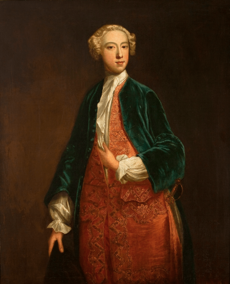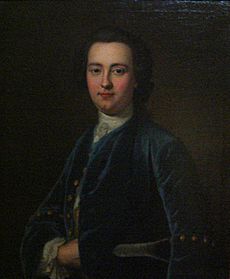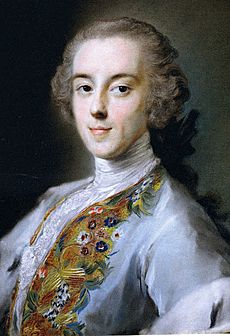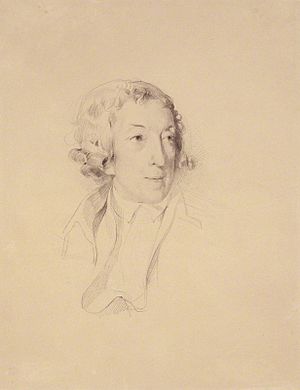Horace Walpole facts for kids
Quick facts for kids
The Earl of Orford
|
|
|---|---|

Walpole by Sir Joshua Reynolds 1756
|
|
| Member of Parliament for King's Lynn |
|
| In office 25 February 1757 – 16 March 1769 Serving with Sir John Turner, 3rd Baronet
|
|
| Preceded by | Horatio Walpole the Elder |
| Succeeded by | Thomas Walpole |
| Member of Parliament for Castle Rising |
|
| In office 21 May 1754 – 25 February 1757 Serving with Thomas Howard
|
|
| Preceded by | Robert Knight |
| Succeeded by | Charles Boone |
| Member of Parliament for Callington |
|
| In office 12 June 1741 – 18 April 1754 Serving with Thomas Coplestone (1741–1748), Edward Bacon (1748–1754)
|
|
| Preceded by | Isaac le Heup |
| Succeeded by | John Sharpe |
| Personal details | |
| Born |
Horatio Walpole
24 September 1717 London, England, Great Britain |
| Died | 2 March 1797 (aged 79) Berkeley Square, London, Great Britain |
| Resting place | St Martin's Church, Houghton, Norfolk |
| Political party | Whig |
| Parents | Robert Walpole Catherine Shorter |
| Residences | Strawberry Hill, London |
| Alma mater | Eton College King's College, Cambridge |
| Occupation |
|
| Signature | |
Horace Walpole (born Horatio Walpole on 24 September 1717 – died 2 March 1797) was an important English writer, art historian, and politician. He is best known for building his unique home, Strawberry Hill House, in a style that brought back the Gothic look.
Walpole also wrote the very first Gothic novel, called The Castle of Otranto. His many Letters are also famous because they give us a great look into the social and political life of his time. He was the youngest son of Sir Robert Walpole, who was Britain's first Prime Minister. Later in his life, Horace Walpole became the 4th Earl of Orford.
Contents
Horace Walpole: A Creative Mind
Who Was Horace Walpole?
Horace Walpole was born in London. He was the youngest son of Sir Robert Walpole, who was the first Prime Minister of Great Britain. Horace followed in his father's footsteps by becoming a politician, but he also became very famous as a writer and art expert.
He loved history and old things, which is why he is also known as an antiquarian. He helped bring back the Gothic style in architecture and writing, influencing many people after him.
Early Life and Education

Horace Walpole went to famous schools like Eton College and King's College, Cambridge. At Eton, he made close friends, including his cousins Francis and Henry Conway. He also formed a group of friends called the "Quadruple Alliance" with Thomas Gray, Richard West, and Thomas Ashton.
While at Cambridge, Walpole was influenced by a thinker named Conyers Middleton. Middleton's ideas made Walpole question some traditional beliefs. Horace left Cambridge without getting a degree.
What Was the Grand Tour?
In 1739, Walpole went on a "Grand Tour" of Europe with his friend Thomas Gray. This was a common trip for young, wealthy men to learn about art, culture, and history. They visited many cities like Paris, Florence, and Rome.
During their travels, Walpole and Gray saw famous sights and met important people. However, they had a big argument and eventually went their separate ways. Walpole returned to England in 1741.
A Career in Politics
In 1741, Horace Walpole was elected as a Whig Member of Parliament (MP) for Callington, Cornwall. He held this seat for 13 years, even though he never visited the town. He entered Parliament just before his father, Sir Robert Walpole, lost his power as Prime Minister.
Horace Walpole supported ideas like ending slavery and was sympathetic to the American colonists' fight for independence. He believed in individual freedoms.
What is a "Rotten Borough"?
From 1754 to 1757, Walpole represented another "rotten borough" called Castle Rising. A rotten borough was a place that had very few voters but still had the right to elect Members of Parliament. This meant that a few powerful people could easily control who became an MP.
Walpole was worried that political disagreements among his own party, the Whigs, would allow the rival Tories to gain too much power. He feared this could lead to a king having too much control. In 1757, he became an MP for King's Lynn and stayed in Parliament until 1768.
Building Strawberry Hill House
One of Walpole's most famous creations is Strawberry Hill House. He started building this unique home in 1749 in Twickenham, near London. He designed it in the Gothic style, which was very unusual at the time.
This playful and imaginative neo-Gothic house helped bring back the Gothic architectural trend many years before it became popular in the Victorian era. It shows his love for history and his creative mind.
His Famous Writings
Horace Walpole was a very active writer. He even had his own printing press at Strawberry Hill, called the Strawberry Hill Press.
The First Gothic Novel
In 1764, Walpole published his most famous book, The Castle of Otranto. This book is considered the very first Gothic novel. It's a story filled with mystery, suspense, and supernatural events.
The novel begins with a strange event: the son of the Prince of Otranto is crushed by a giant helmet that appears out of nowhere. The story combines scary and sometimes silly supernatural elements. It set the stage for many Gothic stories that came after it.
Why Are His Letters Important?
Walpole wrote thousands of letters to his friends and family throughout his life. These letters are very important because they give historians a detailed look at daily life, politics, and society in 18th-century Britain. They are like a personal diary of his time.
In one of his letters, he even invented the word "serendipity". This word means finding something good or useful by accident. He said he got the idea from an old fairy tale. Another famous quote from his letters is: "This world is a comedy to those that think, a tragedy to those that feel."
Walpole also wrote Historic Doubts on the Life and Reign of King Richard III (1768). In this book, he tried to defend King Richard III against the common belief that he murdered the Princes in the Tower.
Later Years and Legacy
After leaving Parliament in 1768, Walpole still kept up with politics. He was very concerned about the French Revolution and praised Edmund Burke's book, Reflections on the Revolution in France, which criticized the revolution.
In 1791, when his nephew died without children, Horace Walpole became the 4th Earl of Orford at the age of 74. He held this title until his death in 1797. He was buried at the Church of St Martin at Tours on the Houghton Hall estate, just like his father.
Walpole's many letters and other writings have been published in many books since his death. They continue to be a valuable resource for understanding the 18th century.
Personal Characteristics
In his later years, Horace Walpole suffered from gout, a painful condition that affects the joints.
Writings

Peterborough Museum and Art Gallery
A close friend and correspondent of Horace Walpole
Horace Walpole's own printing press, the Strawberry Hill Press, helped him publish many of his works.
Non-fiction
- Letter from Xo Ho to his Friend Lien Chi at Pekin [1757]
- Anecdotes of Painting in England (1762)
- Catalogue of Engravers [1763]
- On Modern Gardening (1780)
- A Description of the Villa of Mr. Horace Walpole (1784)
- Walpole, Horace (1987). Historic Doubts on the life and Reign of Richard III, edited with an introduction by Philip Hammond. Gloucester.
- Catalogue of Royal and Noble Authors
- Memoirs of the Last Ten Years of George II
- Memoirs of the Reign of George III
- Walpole, Horace (1844). Letters of Horace Walpole, Earl of Orford, to Sir Horace Mann: His .... 1. Philadelphia: Lea & Blanchard. https://books.google.com/books?id=QoE4AAAAIAAJ&pg=PA339.
- Selected Letters, edited and introduced by Stephen Clarke. New York: Everyman's Library, Alfred A. Knopf, 2017. Reviewed by Margaret Drabble
Fiction
- The Castle of Otranto (1764)
- The Mysterious Mother: A Tragedy (1768)
- Hieroglyphic Tales (1785)
Walpole Society
The Walpole Society was created in 1911. Its goal is to encourage the study of British art history. Its main office is at The British Museum.
Images for kids
See also
 In Spanish: Horace Walpole para niños
In Spanish: Horace Walpole para niños





